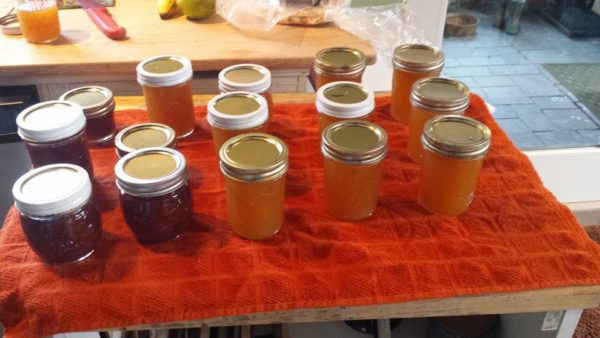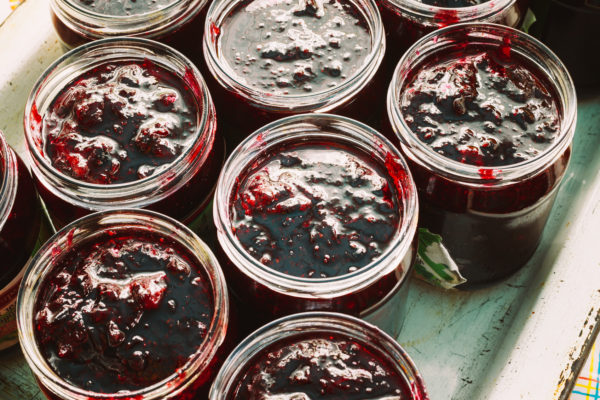Our tips for making your own jams and jellies come from Roberta Bailey. She and her husband Rob run Seven Tree Farm in Vassalboro, Maine, mostly raising seed crops. Roberta also works for Fedco Seeds in Clinton, Maine and is a regular contributor to The Maine Organic Kitchen & Farmer, a newspaper published by the Maine Organic Farmers and Gardeners Association (MOFGA).
Here’s an excerpt from a column Roberta wrote about the abundance of fruit in Maine.
From spring through fall, Maine cranks out the fruit. Our winter weary palates get shocked awake with rhubarb. In June, our eyes roll back with the divine perfection of sun-ripened strawberries. July brings on a rush of fleeting pleasures with raspberries, mulberries, gooseberries, sour cherries, currants and blueberries. In August, the blueberries continue, and fall raspberries, peaches and plums join the earliest ripening apples. September holds grapes, pears, apples, hardy kiwis and cranberries in her arms of plenty.
Anyone interested in preserving such bounty can be kept busy from May through October. Preservation methods are as varied as the fruits themselves.
The method of preservation that we’re going to focus on is turning your bounty into jams and jellies. Roberta shares her method for making low sugar versions. We thought they might be too tart without sugar, but Roberta said,
You can add honey or syrups or imitation sweeteners – or no sweetener – to jams. They may be much less sweet but not really tart. They taste like real fruit and not overly sweet.
Basic Steps for making Jam or Jelly
Mash the fruit and put it through a sieve to remove seeds if necessary or desired. Or prepare juice for jelly. Measure the amount and heat the sieved fruit or the juice until it boils.
Thoroughly mix measured amounts of pectin into honey or sugar (see below) and whisk the mix into the juice or fruit, being sure the pectin does not clump. If you use Stevia as a sweetener, prepare your fruit or juice as above, sweetening it to taste, but incorporate the pectin by blending it with 3/4 c. boiling water for 1 to 2 minutes before stirring it into the fruit or juice.
Bring the mix to a boil again and add the correct amount of calcium water (see below). To make calcium water, mix 1/2 c. water with 1/2 tsp mono-calcium phosphate. You may halve or double the quantity as needed.
Pour the product into sterile jars to can or into jelly jars to freeze. The jam thickens as it cools. Let a teaspoon of jam or jelly cool to test it for thickness. If it’s not thick enough, add more calcium solution and test again.
For jam
- 1/2 to 3/4 tsp pectin per cup of mashed fruit
- 1/4 to 1/2 c. sugar per cup of fruit or 1/8 to 1/3 c. honey, maple syrup or other natural sweeteners.
- 1 tsp of calcium water per cup of fruit.
For jelly
- 3/4 to 1 tsp pectin per cup of juice, and sweeteners and calcium solution as for jam, above.
To make jam or jelly using mixtures of fruits, use the above method, blending pectin into boiling water, fruit juice or cider.
Canning process
To can, fill pint or half-pint jars to within 1/2 inch of the top of the canning jar, screw on the two-piece lids and place the jars in a boiling water bath for 5 minutes. Remove them from the water and let them cool. Check to be sure the seal is depressed.
Jam lasts about three weeks in the refrigerator once it’s opened.
Roberta’s number one cooking tip for someone making jam or jelly for the first time
Try Pomona style low methoxyl pectin and enjoy making jams with more berries than sugar. You’ll also find lots of recipes on their website.
From The Maine Organic Kitchen & Farmer:
Jams and jellies can be made with little or no sugar, or with honey, maple syrup or other natural sweeteners. Low methoxyl pectin, derived from citrus peel (available in health food stores or on the Internet as Pomona’s Universal Pectin) gels with a calcium phosphate solution instead of large amounts of sugar. The pectin and calcium powder come in separate packets. The pectin is mixed with the fruit, and the calcium is added to water to make a solution that is added to the jam or jelly after it is cooked. Calcium causes the fruit to thicken.
Roberta’s favorite jams and/or jellies and why
My favorite jam recipes are marmalades, especially peach ginger marmalade. My favorite jelly is elderberry jelly as it is delicate and so good for you as well.
How long can you keep jams and jellies?
Older jars of food that have maintained their seal are safe to eat. They may lose flavor as they age.




Leave A Comment